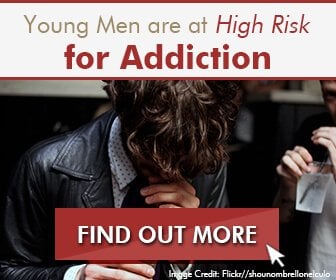Parents, caregivers and teachers are often dismayed by how willing young people are to expose themselves to risk. New research is shedding light on this phenomenon and offering insight into what we can do to help young people avoid dangerous and unnecessary risks.

Sharelines
- Teens’ skewed perception of risk, explained.
- Teens’ high appetite for risk has to do with the way their brains are wired.
As any parent will tell you, trying to help teenagers recognise and avoid risks is an uphill battle. And there are statistics to back this up. For example, when teens drink alcohol, they are more likely to binge than adults. Teenagers also have double the risk of dying than their preteen counterparts. Life for teenagers is dangerous – and a high appetite for risk seems at least partially to blame.
But why do the teens under our care appear to be so comfortable with taking chances and exposing themselves to risk? As a series of relatively new scientific studies have shown us, the answer appears to involve teenage brain chemistry and the way young people are likely to consider and evaluate risky situations.
Teenagers Have a Skewed Perception of Risk
Upon first consideration, it is easy to assume that the teenagers under their care are wildly unaware of potential risks in their lives. While it is true that teens have a skewed perception of what constitutes risky behaviour, it would be inaccurate to say that they are not risk-averse.
In fact, some research has found that teenagers are prone to radically overestimating risks in certain situations. For example, surveys have taught us that teens view unprotected sex and drugs as even riskier than adults do.
The above was uncovered through a study conducted at New York University. According to Agnieszka Tymula, lead author of the study, “Relative to adults, adolescents engage more in unknown risks than they do in known risks.”
When teenagers know the risks (or at least believe that they do), they are less likely to engage in a risky activity. But when the risks are unknown or ambiguous, teens are much likely than adults to take a chance or try their luck. It is the unknown risks that are most problematic for teens.
Teenagers Are More Likely to Take Risks when the Outcome Is Unknown
As we mentioned above, teenagers are prone to overestimating risks in certain situations – but that does not mean that they necessarily abstain from those behaviours. Another study conducted by the Yale School of Medicine found that teens are actually more accepting of unknown consequences.
The report of this study was published in the Proceedings of the National Academy of Science, and pointed out the following:
- Teenagers commit more crimes than any other age group.
- Teenagers drive faster than adults.
- Teenagers contract more sexually transmitted infections (STIs) than any other age group.
The latter is interesting in light of the fact that teens are also likely to overestimate the risks associated with unprotected sex. We will address this in greater detail below.
But first, here are the details of this particular study. Researchers asked volunteers to make decisions related to a lottery and cash prizes. In some experiments, the participants were told their precise odds of winning. In others, they were left to speculate about the odds on their own. In the latter case, the odds (and therefore the outcome) were an unknown entity.
When the teens in the study were informed about the precise risks (ie their chances of losing the lottery), they were as risk-averse as adults – and in some cases even more so. But when the risks were uncertain, they were statistically more likely to take chances than adults.
Teenagers Have a Greater Tolerance for Uncertainty
Studies like these demonstrate that teenagers are more comfortable with uncertainty than adults. They are also more likely to focus on the reward. Adults, on the other hand, are usually more focused on consequences. This is what makes teenagers more likely to engage in risky behaviour even when they overestimate the risks.
Take unprotected sex as an example. The risks of contracting a life-changing disease such as HIV are relatively low – and teens are even likely to overestimate them. For adults, even a relatively low risk is worth avoiding when the consequences are severe or – in the case of HIV – irreversible. This is a consequence-driven approach to risk-taking.
But teens are much less likely to dwell on the consequence. Instead, they are more interested in the immediate rewards of the behaviour. Rather than carefully considering the consequences, they are more likely to get caught up in the potential risks.
And as we will show you in the next section, there is an emerging scientific basis for this type of behaviour. It has everything to do with the growth and development of the teenage mind.
Risk-Taking in Teens Could Be the Result of a Brain Imbalance
A more recent study conducted at Dartmouth College found that risky behaviour in adolescents could stem from an imbalance between sections of the brain – specifically the prefrontal cortex (PFC) and the nucleus accumbens (NAC).
The PFC is involved in cognitive control as well as inhibition. In that sense, the PFC can help us both evaluate risks and abstain from risky behaviours. The NAC, on the other hand, is central to reward-seeking, and can even play a role in addiction.
The study was conducted on animals, but its findings are likely relatable to our brain chemistry. It found that adolescents experienced an imbalance between these two sections of the brain. The PFC exhibited lower activity in adolescents than it did in adults. Meanwhile, the adolescent NAC was more active.
When you take this into account, it seems reasonable to assume that teens are more excited by potential rewards, while lacking in the cognitive ability to hold themselves back from taking risks. This is a recipe for irrationally risky behaviour.
Support Teens by Helping them Better Understand Potential Risks
When teenagers have a concrete understanding of the risks involved with a specific behaviour, they are much more likely to make an informed decision and abstain from that behaviour. The potential consequences of their actions become less of an unknown.
This is a central component of the addiction treatment programme operated at The Edge. We encourage our clients to embrace the patterns emerging from their developing brains without exposing themselves to any serious risks.
Furthermore, we are located in the eco-activity hub of Thailand, and our addiction treatment programme includes plenty of action and activities. This is an excellent way to help our young clients explore the world and engage their sense of adventure in a safe and controlled environment.
Above all, we work with the young men under our care to ensure that they understand the potential risks and consequences of the behaviours they have been engaging in. Contact us today to find out more.





